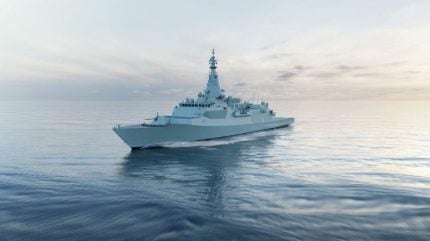
Ottawa-based WR Davis Engineering is the latest Canadian company to join Irving Shipbuilding’s supply chain and support the construction of the future Canadian Surface Combatants, now known as the River-class destroyers, being built for the Royal Canadian Navy.
WR Davis was awarded a contract totalling over C$30m ($21.9m) to design and implement the full engine intake and exhaust system, as well as the infrared suppression devices for the exhaust. This contract will support jobs in the Ottawa-region and be carried out on the first three destroyers, according to a 17 July 2024, release from Irving Shipbuilding.
The engine intake and exhaust systems draw air into the ship’s engines and exhaust the air back out of the engine and ship.
Meanwhile, the infrared suppression devices will protect the ship by cooling the engine exhaust gas and the exposed hot metal, importantly decreasing the ship’s infrared signature and protecting it against heat-seeking anti-ship missiles, including reducing the range at which these missiles can lock onto the ship.
As part of Canada’s National Shipbuilding Strategy (NSS), Irving Shipbuilding is building 15 River-class destroyers. Construction on the production test module of the River-class began in June 2024, with these ships expected to replace the existing Halifax-class frigates as the backbone of Canada’s naval combat capability.
The programme is the largest and most complex shipbuilding project in Canadian history.
Driven by the NSS, this latest supply chain announcement contributes to more than C$3.2bn in total contracts and investments delivered to Ontario by the NSS, Irving Shipbuilding stated.
In June at Irving’s Halifax shipyard, Canadian Minister of National Defence Bill Blair and Vice-Admiral Angus Topshee, Commander of the Royal Canadian Navy, announced the new fleet of combat ships will be known as River-class destroyers, and the first three ships will be named HMCS Fraser, Saint-Laurent, and Mackenzie.
River-class destroyers: Canada’s future surface warrior
Derived from the UK’s Type 26 anti-submarine frigate design, the newly dubbed River-class guided missile destroyers will form the centrepiece for the Royal Canadian Navy’s future surface warfare capability.
It is planned that the 15-strong fleet will replace the existing 12 Halifax-class frigates currently in service, the first of which was commissioned in 1992.
Expected to displace over 8,000 tonnes, the River-class are significantly larger than their Halifax predecessors, which weighed in at around 4,700 tonnes. The River-class frigates will feature advanced sensors, including the AN/SPY7(v)3 solid-state 3D radar, the S2150 hull-mounted sonar, and the AN/SLQ-32(v)6 electronic warfare suite.
Weaponry will consist of 127mm and 30mm main and secondary guns, with anti-surface warfare capabilities including the sub-sonic Naval Strike Missile. Anti-air warfare will be met through the 24-cell Mk41 vertical launch system, able to pack RIM-162 ESSM Block II and RIM-66 SM-2 Block IIIC missiles.
The class will also be to launch BGM-109 Block V Tomahawk cruise missiles, potentially the upgraded Maritime Strike variant.





